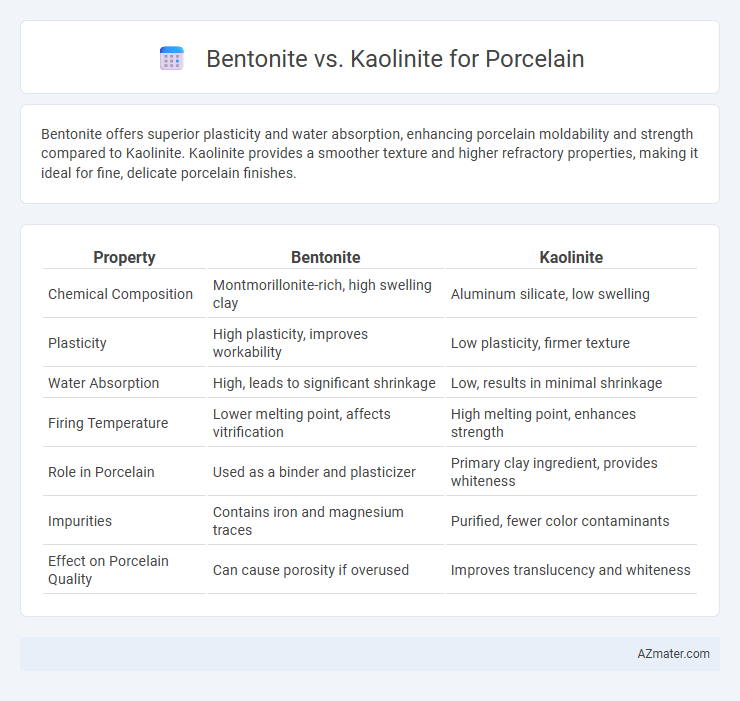Bentonite offers superior plasticity and water absorption, enhancing porcelain moldability and strength compared to Kaolinite. Kaolinite provides a smoother texture and higher refractory properties, making it ideal for fine, delicate porcelain finishes.
Table of Comparison
| Property | Bentonite | Kaolinite |
|---|---|---|
| Chemical Composition | Montmorillonite-rich, high swelling clay | Aluminum silicate, low swelling |
| Plasticity | High plasticity, improves workability | Low plasticity, firmer texture |
| Water Absorption | High, leads to significant shrinkage | Low, results in minimal shrinkage |
| Firing Temperature | Lower melting point, affects vitrification | High melting point, enhances strength |
| Role in Porcelain | Used as a binder and plasticizer | Primary clay ingredient, provides whiteness |
| Impurities | Contains iron and magnesium traces | Purified, fewer color contaminants |
| Effect on Porcelain Quality | Can cause porosity if overused | Improves translucency and whiteness |
Introduction: Understanding Bentonite and Kaolinite in Porcelain
Bentonite and kaolinite are essential clay minerals used in porcelain production, each contributing distinct properties to the final product. Bentonite, rich in montmorillonite, enhances plasticity and water retention, improving workability and shaping of porcelain. Kaolinite, a primary component of traditional porcelain, provides whiteness, chemical inertness, and high firing temperature stability, crucial for achieving the material's characteristic strength and translucency.
Chemical Composition: Bentonite vs Kaolinite
Bentonite primarily consists of montmorillonite, a smectite group clay mineral rich in aluminum silicate with high swelling capacity due to its layered structure trapping water molecules. Kaolinite, the main clay mineral in porcelain, is composed of a 1:1 layer of aluminum silicate (Al2Si2O5(OH)4) with lower plasticity and minimal swelling, providing smooth texture and high firing whiteness. The distinct chemical compositions influence their performance, with bentonite enhancing plasticity and water absorption, while kaolinite imparts strength and whiteness to porcelain bodies.
Mineral Structure Differences
Bentonite primarily consists of montmorillonite minerals with a layered, expandable structure allowing high water absorption, while kaolinite features a non-expandable, tightly bound 1:1 clay mineral structure with limited plasticity. Bentonite's smectite group minerals contribute to its swelling properties, influencing porcelain workability and firing characteristics differently from the stable, less reactive kaolinite. These structural differences affect glaze interactions, plasticity, and the firing range in porcelain production, making kaolinite more suitable for fine, white-bodied porcelain and bentonite effective as a plasticizer or binder.
Plasticity and Workability in Porcelain Production
Bentonite exhibits superior plasticity compared to kaolinite, enhancing the workability of porcelain clay bodies by improving moisture retention and flexibility during shaping processes. Kaolinite, with its lower plasticity, offers greater refractory properties but requires blending with more plastic materials like bentonite to achieve optimal forming characteristics. Consequently, bentonite's high swelling capacity plays a crucial role in increasing green strength and reducing cracking, making it indispensable in fine porcelain production.
Impact on Porcelain Firing Temperature
Bentonite and kaolinite have distinct impacts on porcelain firing temperatures due to their mineral compositions and plasticity. Bentonite, rich in montmorillonite, increases plasticity but requires lower firing temperatures, typically around 1200degC to 1250degC, to prevent warping or cracking. Kaolinite, a primary clay mineral with lower plasticity, supports higher firing temperatures near 1300degC, producing denser, more vitrified porcelain with enhanced whiteness and strength.
Influence on Porcelain Strength and Durability
Bentonite enhances porcelain strength by improving plasticity and particle cohesion, leading to fewer cracks during drying and firing. Kaolinite contributes to durability through its high alumina content, which forms a stable, dense microstructure after firing, increasing resistance to mechanical stress and chemical attack. The optimal porcelain formulation balances bentonite's plasticity with kaolinite's refractoriness to maximize overall strength and long-term durability.
Color and Aesthetic Effects in Finished Porcelain
Bentonite imparts a slightly grayish tint in finished porcelain, enhancing opacity and providing a subtle matte texture that can influence the brightness of glazes. Kaolinite offers superior whiteness and translucency due to its high purity and fine particle size, resulting in a brighter, more refined aesthetic in porcelain products. The choice between bentonite and kaolinite significantly impacts the final color uniformity and surface smoothness, crucial for high-quality, visually appealing porcelain ware.
Water Absorption and Shrinkage Rates
Bentonite exhibits higher water absorption rates than kaolinite, enhancing plasticity and improving workability in porcelain production. Kaolinite's lower water absorption contributes to reduced shrinkage rates during firing, resulting in better dimensional stability and less warping. The choice between bentonite and kaolinite impacts the balance between shrinkage control and firing durability in ceramic formulations.
Cost and Availability for Porcelain Manufacturers
Bentonite generally offers better plasticity at a lower cost, making it a preferred choice for porcelain manufacturers aiming to reduce production expenses. Kaolinite, while more expensive and less abundant, provides superior whiteness and purity, which are critical for high-quality porcelain products. Porcelain manufacturers often balance these minerals' availability and cost to optimize both production efficiency and final product aesthetics.
Choosing the Right Clay: Bentonite or Kaolinite for Superior Porcelain
Bentonite and kaolinite serve distinct roles in porcelain production, with kaolinite being the primary clay known for its whiteness, plasticity, and high refractoriness, essential for creating fine, translucent porcelain. Bentonite, rich in montmorillonite, is added in small amounts to improve plasticity and workability without affecting the porcelain's firing properties or final whiteness. Selecting the right balance between kaolinite for purity and bentonite for molding quality ensures superior porcelain characterized by durability, smooth texture, and aesthetic brilliance.

Infographic: Bentonite vs Kaolinite for Porcelain
 azmater.com
azmater.com